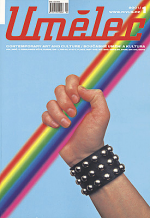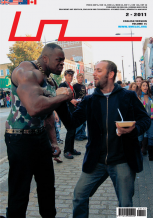| Umělec magazine 2001/2 >> Who`s the Man | List of all editions. | ||||||||||||
|
|||||||||||||
Who`s the ManUmělec magazine 2001/201.02.2001 Jeffrey A. Buehler a Denisa Kera | q & a | en cs |
|||||||||||||
|
"RtMark: Interview with Ray Thomas by J. A. Buehler and Denisa Kera
Hooray! The now nearly mythical corporate pranksters, RtMark, were coming to town, or at least Ray Thomas, their spokesperson, was. It seemed time to finally get some answers (and maybe put a face to) some of the provocative issues these corporate media activists have a knack for raising: this mysterious group has been accused of everything from corporate terrorism to contemporary art. They first hit the papers back in the early 1990s when they helped finance the great Barbie/GI Joe voice-chip swap, which resulted in gender disorientation for several hundred infants. In time they formed a corporation of their own and began mimicking corporate strategies, mainly through Internet propaganda and press releases. They set up a database of mutual funds on their website, RtMark.com, which allowed anyone to contribute to or participate in oftentimes hilarious corporate sabotage. (“Since U.S. corporations are by law U.S. citizens, it should be possible to marry one. Successfully marry an actual corporation, so that the marriage is legally binding; the event must be reported in the media.”) After a sometimes inspiring, sometimes grueling eight-hour workshop led by Ray and Petr Motyčka from the Czech art activist group Podebal, we managed to sit down for a few minutes among the twisted steel piping in Universal Space NoD, where Ray’s intensity and sincerity seemed to find a natural home. Could you talk briefly about the history of RtMark? It formed in 1993 when we did our first action, Barbie/GI Joe, and we’ve done many actions since. But for the most part, we don’t actually do actions: We support them. We basically write press releases and try to engineer events. The Bush website we did ourselves, Voteauction [voteauction.com] we didn’t do. So it’s all kind of mixed. Basically the history is sort of vague, long and twisted, but the point is we try to be a public relations agency like a corporate public relations agency, write press releases that get our ideas in the news just like corporate public relations firms do. Like Hill and Knowlton that basically have as a client the Kuwait government and helped the Kuwait government to defend themselves against the Iraqis by lobbying the American public through various means so that eventually the American public and Congress voted for the war and, you know, decimated Iraq. We’re trying to promote various ideas. But it’s that kind of public relations, where we use a whole range of different techniques. How did you get the idea to organize your activism through ironizing corporate strategies? Well, it’s not really ironizing them. The way we see it, we’re actually using them. On the one hand, for you and others, it’s funny, and we project this serious look that for many people is very funny, but there’s no joke in there. We don’t say: “Ha, ha, this is funny.” It’s all very straightforward and it does communicate what it says it’s communicating. They’re not fake press releases. They’re real press releases and our website is not making fun of corporate websites: It is a corporate website. It’s using a lot of corporate techniques, so it’s not irony, the way we see it. On the other hand, it’s easy to see it that way. A lot of the projects we have done are funny. What we’re doing is using humor to get the story into the news. When there’s humor involved, like with Voteauction or when G. W. Bush makes a big fool of himself and turns into a clown on TV or when the WTO does something like that, whenever there’s humor, it’s a good story. Who were you inspired by or who were your influences? There are so many influences it’s all a mush. There are so many important people who have done this kind of work: the Yippies throwing money on the stock exchange floor; there’s TVTV (Top Value Television), which went around with a Sony handheld camera and did amazing reporting on the Republican National Convention of 1972; there’s Brian Springer who’s exposed the way presidential campaigns are run and the whole way the news releases are put together and the way corporations influence politics. And there’s Joey Skaggs who’s done these clever pranks that are kind of just pranks. Their point is to expose how stupid the media is, which is for us not a valid or interesting point, it’s just one point among many, but it’s his point. But his technique is amazing and he’s extremely good at what he does, so that’s inspiring. Then there’s the Billboard Liberation people who deface billboards in interesting ways. It goes on and on. Who actually started RtMark? There’s a few people behind it. They met on the Internet and one of them was a political scientist and I think there was another academic. About four people got together and decided to put some energy into it and decided to make a system that would make sense, but you know it’s changed over the years and gotten more refined. In around 1996, 1997 it took its present form. Is there a connection between what you do and contemporary art? Well contemporary art likes it. Curators like it sometimes and art institutions sometimes like it and they see it as an art expression, and of course it is, the same way that many things are art expressions, like Flamenco music or jazz music; it’s all art. It all has a point and does something. It all has a social message. Art is not widely enough defined: It includes us, but it doesn’t include jazz and Flamenco, but it should. It doesn’t include graffiti, except in a very minimal way, but a lot of graffiti is just as much art as anything in museums. You know, social movements are also art. Like the protests in Seattle and the movements that rise out of them should be considered art and they should all get art funding. Art museums should spend their budgets on promoting this kind of social art now because it’s really what is most interesting in creative life. What is essentially being created among social groups in these activist circles is the most interesting esthetic product on the planet, and the most interesting theoretically, intellectually. Museum budgets should be going towards this kind of art, but it isn’t, so we fit in more neatly... It is basically useful to us. We would like to see the definition of art expanded because then it gives it this kind of cachet, gives us some acceptance and money. So to call yourself an artist would be more of a tool? Yeah, so we never do it. Except when it comes to asking for money. It may be useful in Europe. It gives you a certain amount of respectability. In the States it’s anti-useful. It really diminishes your effectiveness so we’re very careful never to say “art” when we’re talking about what we’re doing. What are some of the strategies that you use in relation to the mutual funds on your website? The main strategy of the whole RtMark system is to inspire people to do these projects, join up and get involved in doing things. To some degree it works. Do you do terrorist actions like the Billboard Liberation group? We don’t, but we support them. What has been the most successful campaign so far? I guess that becomes an abstract question, which I should answer abstractly. We kind of take the corporate image and metaphors and make them our own. We redefine profit. All corporations are seeking only profit and they don’t care about anything else. We are only seeking profit too, what we call cultural profit, and we define that by the amount of attention we can draw to corporate abuse. The most successful campaign is the one that gets the most profit, in other words, the most press. The number of articles written about it defines how successful it is. Also the amount that it communicates what we want to communicate. Probably Voteauction.com [was the most successful] because it got a tremendous amount of press and communicated clearly the idea that corporations buy democracy, which is our central thought. The etoy fund, which helped save the art group etoy and helped destroy [the corporation] etoys.com, was successful in terms of press also, but it did not communicate as clearly. It did communicat that it’s possible to fight these companies. But these companies always win if you’re not good at PR. We’re good at PR so we won. It mis-communicated some things, gave the wrong impression, but also gave some good ideas. It was something of a success. GWBush.com was also pretty successful. How many members are there in RtMark? It changes. There’s about six now. I work a lot on the website. Other people do the finances. We all write press releases, which is the main activity of RtMark, writing press releases, we all collaborate on that. How do you see the future of corporate enterprise in the States and the rest of the world? Well, in the east of Europe, it’s kind of scary because you have the situation where there was no exposure to corporate behavior before a certain point. Corporations have had a hundred years to figure out strategies to accomplish what they want. People are in a vulnerable position and corporations are ready to do something about it. There’s not a lot of protection. I presume there’s a lot of abuse of the law and the environment without a lot of ability to defend. It’s scary because corporations, given this situation, have often accomplished really big things. General Motors in collaboration with Standard Oil and B.F. Goodrich destroyed public transportation in the United States in the 1940s. People didn’t know what was going on and they did it through public relations. They did it by subtle means that were not perceptible at the time. Anything is possible. As far as the rest of the world goes, different parts of the world are becoming aware of what’s going on, but at the same time the awareness has caused the corporations to take it to the next level. The real solution and what may result from all of this is that laws will be changed and the WTO will not be allowed to do the things they do. Getting governments to recognize this is not reasonable, and people don’t want corporations to have free reign over the world. How do the corporations react to what RtMark does? Occasionally they criticize us a little bit but they try not to. Do you feel a lot of pressure? No. It’s really hard to know what’s going on. When we were attacking etoys.com constantly, we didn’t hear a word from them ever. They never said anything, which doesn’t surprise me because they knew that if they said anything, it’s news automatically. It would have been worse for them if they had reacted. And corporations know that. But I’ve heard from several sources that people within etoys.com were really upset and there was this high-crisis atmosphere. People there hated RtMark. So it’s very flattering. Who is the worst enemy? There is no enemy as far as corporations go. Corporations are not the enemy. They’re just these machines. They’re neutral. They do what they do; they do what they’re designed to do. And of course if you give them lots of power they will do more of it, so you can’t hate them and think that they’re evil. They’re like a car that runs over people. That’s what it’s designed to do, so it does it. But they have way too much power. The target of RtMark is not corporations; we’re trying to increase outrage. But the ultimate goal is to change the laws so that corporations are given less laws than they have now. The real enemy is public relations, this amazingly long-lived public relations effort by corporations for a hundred years or more to convince people that corporations are okay, each separately and all put together, these faces they give themselves through enormous expense, to make them seem friendly and nice, and it’s all for advertising to make money. The cumulative effect is that people end up trusting corporations, and that people don’t protect themselves. "
01.02.2001
Recommended articles
|
|||||||||||||
|
04.02.2020 10:17
Letošní 50. ročník Art Basel přilákal celkem 93 000 návštěvníků a sběratelů z 80 zemí světa. 290 prémiových galerií představilo umělecká díla od počátku 20. století až po současnost. Hlavní sektor přehlídky, tradičně v prvním patře výstavního prostoru, představil 232 předních galerií z celého světa nabízející umění nejvyšší kvality. Veletrh ukázal vzestupný trend prodeje prostřednictvím galerií jak soukromým sbírkám, tak i institucím. Kromě hlavního veletrhu stály za návštěvu i ty přidružené: Volta, Liste a Photo Basel, k tomu doprovodné programy a výstavy v místních institucích, které kvalitou daleko přesahují hranice města tj. Kunsthalle Basel, Kunstmuseum, Tinguely muzeum nebo Fondation Beyeler.
|





































 New book by I.M.Jirous in English at our online bookshop.
New book by I.M.Jirous in English at our online bookshop.
Comments
There are currently no comments.Add new comment